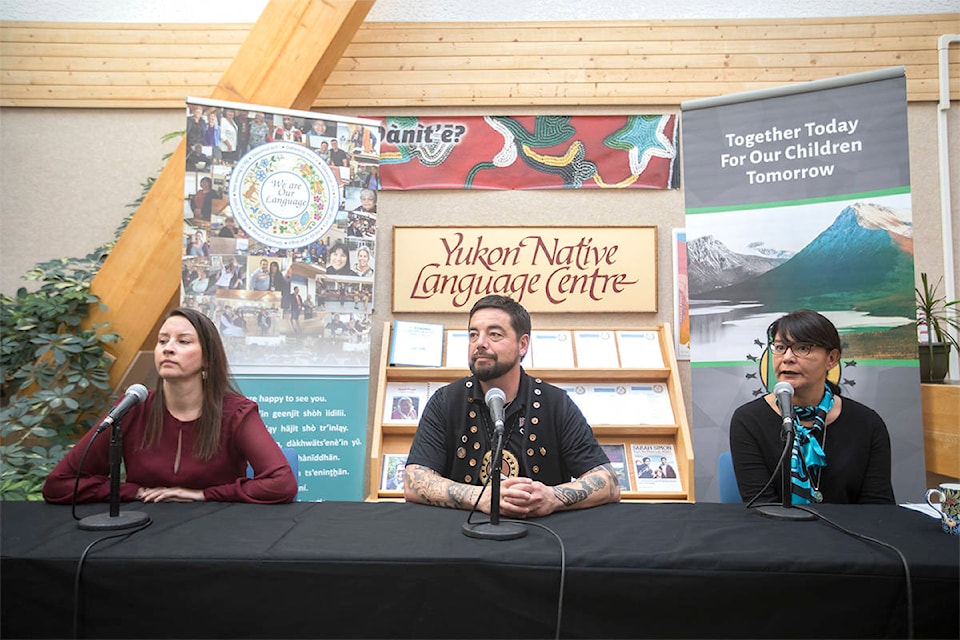It could be said that much of Randel Kendi’s life work has been largely focused on ensuring the Gwich’in language is taught to a new generation.
As a teacher he’s shared the language and culture with students at Chief Zzeh Gittlit School in his home community of Old Crow and at F.H. Collins Secondary School in Whitehorse.
And now working as the receptionist for his First Nation’s office in Old Crow, he addresses most who drop by — especially the youth — in Gwich’in. As a community volunteer, he helps ensure the language is heard at the Anglican Church and at many events, remaining an important part of the every day culture.
| Randel Kendi of Old Crow is one of the participants in the Yukon Native Language Centre's new language video project in Whitehorse on October 9, 2019. (Crystal Schick/Yukon News) |
Kendi said he’s always pleased to hear youth speak to him in Gwich’in.
“It makes me proud,” he said.
It isn’t until now though that technology has become part of Kendi’s work to ensure the Gwich’in language continues to be spoken.
“I received a call at work and the next thing I know I’m here,” he told reporters the afternoon of Oct. 9 as he sat in a classroom with 13 others at the Yukon Native Language Centre inside Yukon College’s campus in Whitehorse.
Like the others, Kendi had recording gear on the table in front of him, at the ready for his next assignment.
Kendi is among a group of trainees — with one from each of the Yukon’s 14 First Nations — learning about film production as part of a project that aims to preserve the eight distinct Indigenous languages in the territory.
Over the next six months, Kendi and the other trainees will be learning about how to best produce videos while interviewing elders from their First Nation. The result will be 280 videos documenting the language and culture. Some of the videos will be available for all through the Yukon Native Language Centre’s web site. Others — those that contain sacred stories, for example — will be documented and kept with the First Nation.
Each trainee has been provided with a recording kit that includes a digital recorder, Macbook Pro, iPod, a lighting dock, an iPod kit for video recording and a hard drive. At the end of the program, language departments for each First Nation will receive the kit for future projects to preserve their language.
On Oct. 7, the trainees began their first week of the program, focused on learning the ins and outs of the equipment. How to best shoot an interview, making sure the audio and video portions are connected and so on.
Before speaking to reporters on Oct. 9, Kendi and the others had taken turns doing mock interviews with one another that the class was getting set to review with instructors that afternoon. Things like framing, pointers on getting the best audio were all set to be discussed as the students and instructors went through the videos.
After the week long workshop, the trainees will return to their communities to begin work on their interviews with local elders.
It’s an initiative Kendi is excited about as he gets set to interview elders in his community when he goes back home. There are a lot of old stories he said he’s anxious to record for future generations.
“I really like this program,” he said, adding he’s especially excited to learn more in future workshops, the next one coming up in November.
Another workshop in February will follow, focused more on the finished project and getting it out into the world or keeping it with the First Nation.
For Peter Johnston, grand chief of the Council of Yukon First Nations, the project is “another tool, another mechanism we can utilize” in putting language at the forefront.
“Language is everything to us,” Johnston said.
As Tina Jules, director of the Yukon Native Language Centre, said, the initiative will build capacity within individual First Nations to document their language, but that’s not all it’s about.
It’s also about building a connection between generations, she said.
While this project will focus on interviewing elders and documenting their stories, at least one trainee is looking further down the road at what it might mean for their First Nation.
| Gary Sidney Johnson of the Carcross/Tagish First Nation at the Yukon Native Language Centre's new language video project in Whitehorse on October 9, 2019. (Crystal Schick/Yukon News) |
Gary Sidney Johnson of the Carcross/Tagish First Nation is already well known in his community for his work to learn his language and teach it to others as well as being part of the Dakhká Khwáan Dancers.
Bringing that culture to the next generation of CTFN citizens is a big focus for Sidney Johnson. He does that with a series of puppet shows he puts on for local kids in Carcross. There’s a moose, frog and more animals helping youngsters learn their culture.
He said he hopes to someday incorporate the recording skills he’s learning into productions with the puppets.
Project coordinator Douglas Joe, a member of the White River First Nation, said he’s pleased to be part of an initiative that will document the First Nation languages in the territory as well as provide on ongoing legacy as First Nations will be gifted the equipment that will lead to future projects.
“We want to document the languages,” he said.
The $315,000 project is funded through the National Research Council of Canada’s Indigenous Language Technology initiative and CYFN, which has been overseeing the work of the Yukon Native Language Centre since 2018.
CYFN will host a celebration and launch the videos on Aboriginal Languages Day March 31, 2020.
Contact Stephanie Waddell at stephanie.waddell@yukon-news.com
